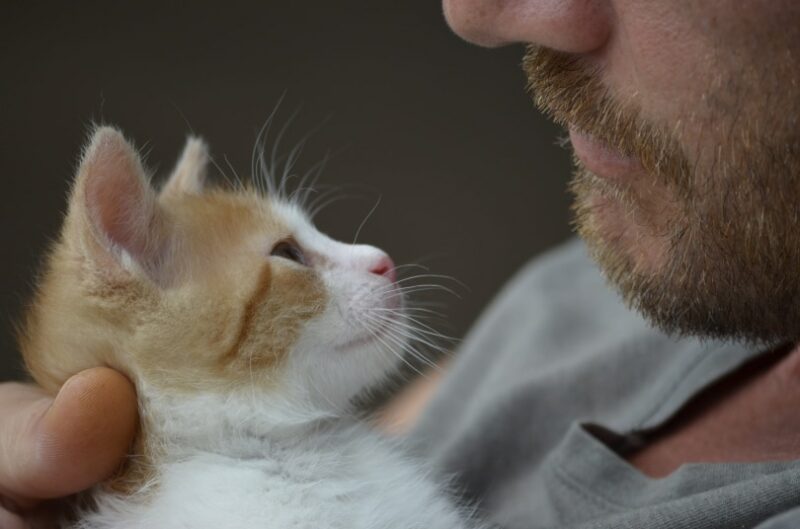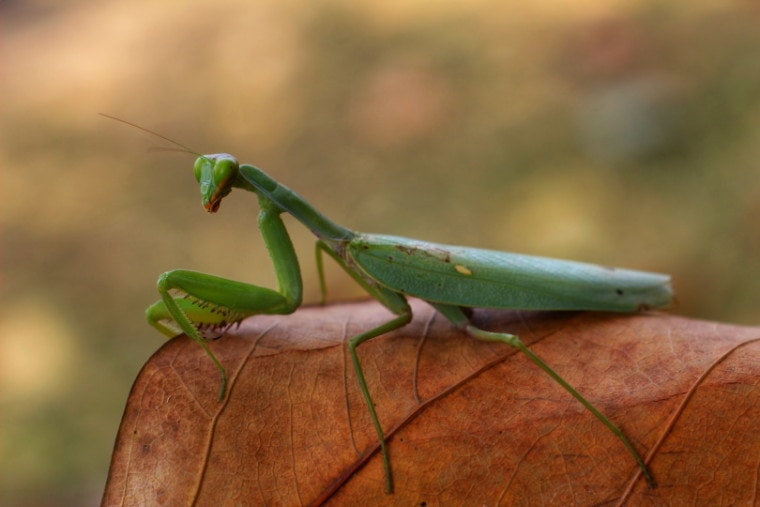
The term “African Praying Mantis” refers to several species of praying mantis that live in Africa: the African twig mantis, the African grass mantis, or the African bark mantis. While all these insects live in Africa, they are quite different from each other. When it comes to pets, though, the Sphodromantis lineola is usually the species being referred to.
This species of praying mantis is native to Africa and is most distinguished by the blue-black spots on their forearms. They’re often considered a fierce and large species of mantis, which is why they’re often kept as a pet. They’re relatively easy to care for and have an exciting hunting technique.
Quick Facts About African Praying Mantises
| Species Name | Sphodromantis lineola |
| Family | Mantidae |
| Care Level | Low |
| Temperature | 75°F |
| Temperament | Aggressive and bold |
| Color Form | Green |
| Lifespan | 1 year |
| Size | 8 cm for females, 6–7 cm for males |
| Diet | Insects |
| Minimum Tank Size | Depends on size |
| Tank Set-Up | Minimal |
| Compatibility | None |
African Praying Mantis Overview
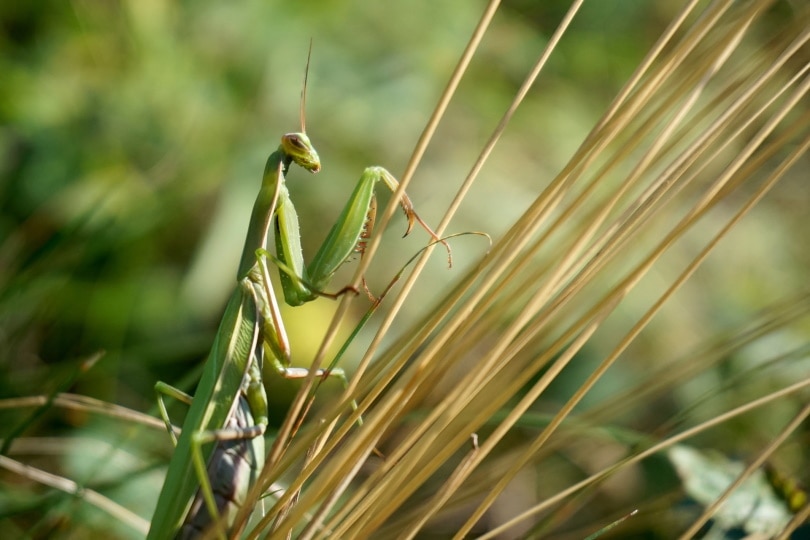
If you’re interested in keeping insects, the African Praying Mantis is an excellent place to start. They are fascinating insects with plenty of unique behaviors to watch. Of course, they aren’t exactly going to be very affectionate. Their aggressive nature is one of the reasons that many people decide to keep them as pets. They are simply one of the most interesting insects to watch, especially when they are hunting.
These insects are pretty easy to care for, which makes them a suitable option for most beginners. They don’t have high demands for humidity and have easy temperature requirements. They don’t require a massive tank by any means, so you can often fit them in small areas. They are not picky about their food and don’t require a super-specific diet.
For those interested in getting into keeping insects, this is a great place to start. Experts will also find them entertaining to keep, and they may provide a break from other high-need exotic pets. However, you should understand that they are an insect, not a dog or cat. They have entirely different needs and behaviors. They do not show affection and typically shouldn’t be handled very much. Instead, most of your time will be spent watching them.
How Much Do African Praying Mantises Cost?
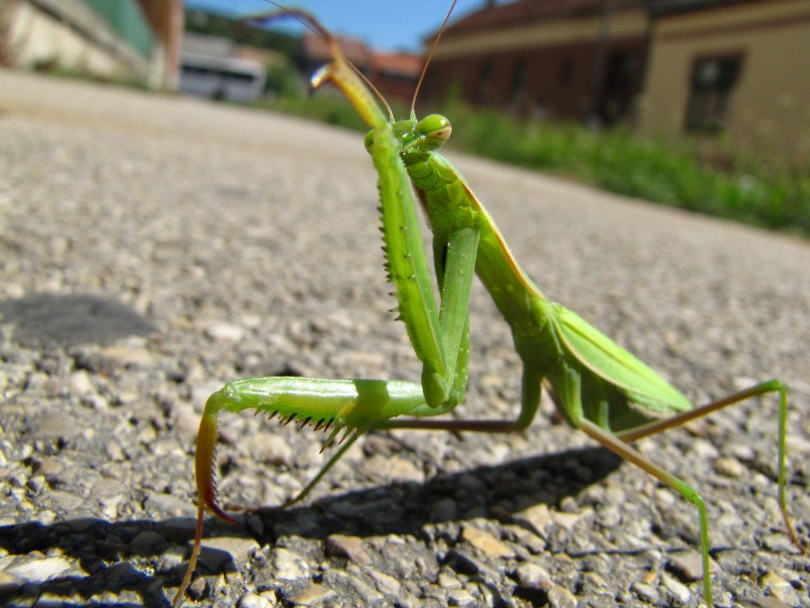
These insects are typically cheap. You can purchase one for about $26, which is less expensive than most other exotic pets out there. It can be challenging to find one locally, though, since they are a niche pet. However, online stores often have them, and they are hardy enough to survive shipping in the right conditions.
Of course, you should do your research and ensure that you purchase from a company that has high-quality insects and knows how to ship correctly. Insects typically don’t require particular shipping conditions, but care must still be taken to ensure that they survive transit.
If you can find a local breeder, this is the best option. The mantis will not have to be shipped, which is better for everyone involved. Plus, you can see where the insect is kept, which will give you a clue about the animal’s health.
Typical Behavior & Temperament
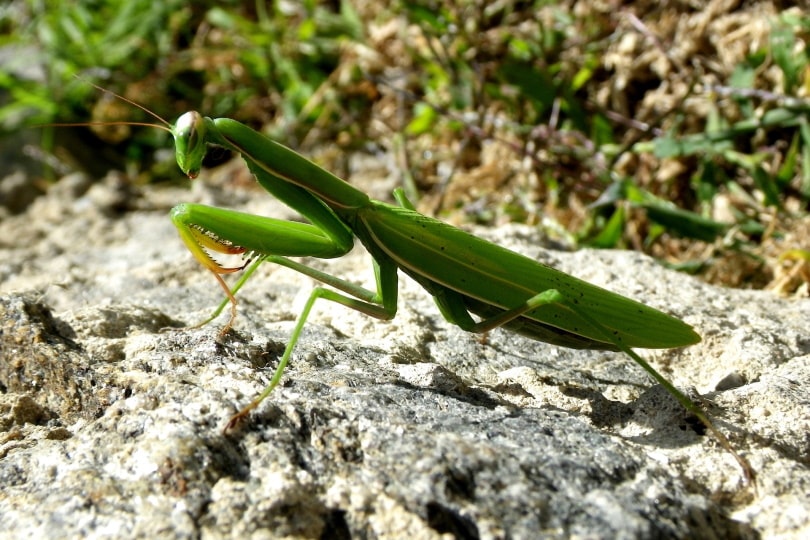
These insects are highly fierce, even when kept in captivity. They will actively hunt their prey, which makes them very fun to watch. Many will run across their tank after they have spotted it. They can handle prey much larger than themselves. However, they can get somewhat intimidated by large prey and will go on the defensive instead of actively hunting it. It is often best to avoid substantial prey items like locusts. When they feel threatened, they will move their front arms sideways. This exposes the orange-colored areas.
These mantises cannot live together, as they are cannibalistic. They will actively hunt each other. Eventually, there will only be one left, as all the others will be eaten. However, the victorious one may also be too injured to heal correctly, so you may end up with no mantises at all.
The African Praying mantis is an aggressive species. This means they are bolder and easier to watch, as they are less likely to hide.
Appearance & Varieties

Usually, these praying mantises are some shade of green. They can range to beige or even be tinted brown, though. The differences are not precisely controlled by genetics, however.
The brown varieties often have purple-ish eyes and are highly sought after. But it is essential to remember that the environment plays a massive role in these insects’ coloration, and this species can change color over their lifespan. Just because you purchase a brown mantis doesn’t mean they’re staying brown.
Females can get up to 8 cm long, making them one of the largest mantis species that you can keep as pets. The males are usually a bit smaller at 6 to 7 cm. They will also need smaller prey due to their size. Males are thinner and may be a bit shyer and more docile. They can also be a bit more fearful and less confident.
How to Take Care of an African Praying Mantis

Habitat, Tank Conditions & Setup
As a rule of thumb, you should keep these insects in an enclosure three times as tall as they are long and at least two times as wide as their length. Females can reach up to 4 inches as adults. This means you’ll need an enclosure that is at least 8 inches in length and 12 inches tall. Of course, larger enclosures are recommended if you have the room. These insects are active and will use every inch of space you give them.
Ventilation
Adequate ventilation is essential. There must be some mesh on the top of the tank and something for them to access the mesh with. They need to hang upside down to molt, and outfitting the top of the tank with something that they can grip onto is the best option. There should also be empty space around this area that is at least twice as big as the mantis. This enables them to molt properly without things getting in the way.
Live Plants & Substrate
Live plants are excellent options for these mantises, as they typically do not trample plants. Silk plants are also suitable options. While these mantises don’t need plants, they do provide hiding places should the insects become scared. An easy-to-change substrate is recommended, such as sphagnum moss or simply paper towels. This substrate will need to be changed weekly.

Size
These mantises are not picky about their container as long as it is big enough. Besides that, everything else is up to you. Many people prefer plants, but the insect really won’t care about which plants you pick. Just ensure that they are safe for insects.
Temperature, Humidity & Lighting
The ideal temperature is around 75°F, which is about the average room temperature in most homes. A temperature of 68°F to 80°F can be tolerated with some success. You may want to use a heater placed outside the glass if your home gets colder than this regularly. Keep the tank out of direct sunlight, as this can heat it substantially.
The enclosure should be lightly misted at least once a day. Humidity should be kept at 40% to 60%, which isn’t difficult. However, the misting is mainly to allow the mantis to drink. You should not spray the insect directly, as most do not like this. Instead, spray around them or on the opposite side of the tank than they’re currently in. If they get them wet by accident, this typically isn’t a big deal.
Do not use plain tap water, as this often contains chemicals that make it safe for people to drink but can harm insects. Instead, spring water or filtered water is your best option.
Do African Praying Mantises Get Along With Other Pets?
No. They will eat just about everything that is smaller than them. They are very aggressive and will attack just about everything, including relatively large things. They will eat each other, with adults usually being the most aggressive.
For this reason, they are best kept entirely alone.
What to Feed Your African Praying Mantis

These insects have fierce appetites and are not picky about their diet at all. As long as the prey animal is small enough to be eaten and not injure the mantis, they will likely eat it just fine. Tiny praying mantises will need to eat small fruit flies and similar foods. As they get bigger, you can graduate to small cockroaches and house flies. Adults can typically eat cockroaches and similarly-sized insects.
They will continuously eat. They are also willing to tackle prey that may harm them, so it is essential to screen anything before giving it to them. They may even attempt to eat mice!
Due to their appetite, they will overeat quite easily. You should avoid overfeeding them to prevent serious health problems. Like many species, mantises can become obese. If their abdomen begins to get round, they need to go a bit without eating.
You should avoid feeding them insects like wasps and bees, as these can harm them even though they are smaller than them. Don’t feed them insects that you have caught outside, as these will often contain parasites and insecticides.
Keeping Your African Praying Mantis Healthy

As long as you properly take care of them, these insects are pretty healthy. They are not prone to any specific health problems and generally go through life effortlessly. They are one of the easiest species to take care of, primarily due to their hardy nature.
They can get parasites if fed contaminated food, so it is essential to avoid feeding them things that may contain parasites. Only feed them insects that were bred to be fed to pets. Insects that you catch outside are not suitable, as these will likely contain parasites.
Their eyes are prone to damage. Often this happens because of aging or continuously walking into the tank’s wall. Black dots will become apparent in their eye when this happens. These single dots are damaged eyes inside the larger “facet” eye.
However, when the whole eye turns black, it can signify a bacterial or fungal infection. An infected praying mantis should be isolated (if they aren’t already kept alone). Be very cautious not to pass this disease on to other praying mantises that you may own.
Missing limbs can occur due to injury, usually by another praying mantis. They aren’t friendly toward each other and should be kept separate to avoid these injuries. Molting can also cause problems if something goes wrong during the process. However, this is not serious in the least. The limb is often repaired with the next molting. Sometimes, an extra molting may occur quickly for the praying mantis to fix themselves.
During molting, it is good to keep the humidity on the higher side of the scale, as this helps the process move along. Otherwise, the skin may be too dry and become stuck, which can lead to deformities. You should leave the insect alone until they are done molting, as interrupting the process can also cause serious problems. As long as the insect can still eat and walk, they can typically molt to fix themselves.
Crooked wings can occur, especially in more enormous mantises, like the females often are. The final time the praying mantis sheds, it must be completely vertical. The wings are hardened into the correct position by gravity. If this is not possible, the wings will not form correctly. In captivity, this is not much of an issue. If females have crooked wings, they may have difficulty breeding, though.
Food denial is expected when the mantis is about to molt and shouldn’t be cause for concern. If the insect continues to refuse food and does not molt for a few days, it is likely a sign that the parameters of their habitat are off. Check the humidity to ensure that it is not too high, as this is a common mistake.
Breeding
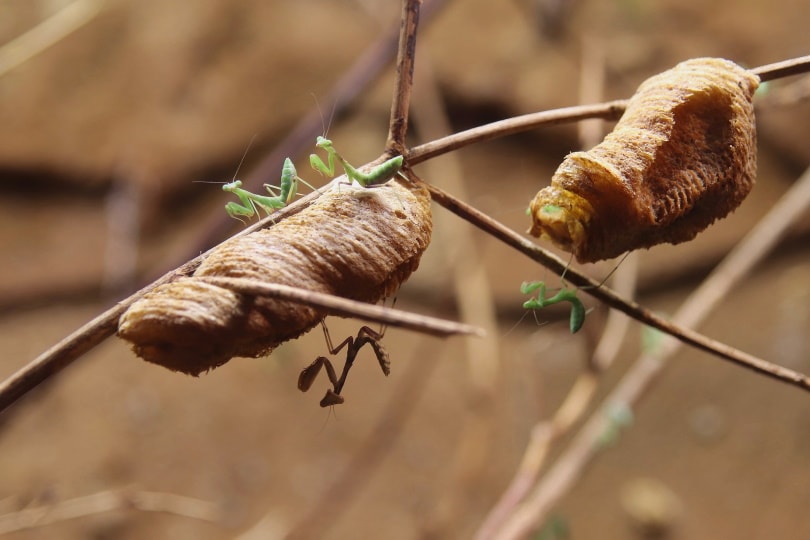
The females are bigger than males and have a different number of segments on their bodies. This makes it extremely easy to sex them properly. You will typically have to wait until they get a bit older, though, as they can be hard to tell apart when they first hatch.
After the mantis performs their last molt, a mating attempt can be made. Typically, we recommend waiting a few weeks so the mantis can regain their strength after the final molt. The female should be fed very well to ensure that she is open to mating (otherwise, it can be terrible for the male). Even if the female is fed, she may not be open to mating and may attempt to eat the male.
You should start with the largest enclosure that you can find. The male should see the female first, so preferably put him behind her. Feed the female immediately after placing the male so she is satisfied. Make sure you keep your eye on the male, as they can typically tell if the female wants to eat them or not. If they seem to run around or panic, remove them. They know what’s going on better than we do.
After the mating is done (which can take several hours), you should remove the male. Otherwise, he will get eaten. You only have to mate a female once. After that, she is fertilized for the rest of her life and will continue to produce eggs.
Are African Praying Mantises Suitable for You?
If you’re looking for a good starter insect, this species is a good option. They are large and hardy, which makes them easy to take care of. They are also one of the bolder mantis species, making them quite entertaining to watch. They have an active hunting style that keeps things interesting. They are one of the more aggressive species, though, so you cannot keep them with other animals in any circumstance.
They are big, so their enclosure needs to be a bit larger than that of most other insects. However, they are still much smaller than other exotic pets. If you’re low on room, they can absolutely be a suitable option.
Featured Image Credit: Kp Rath, Shutterstock



